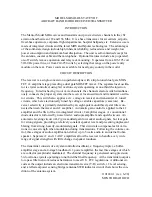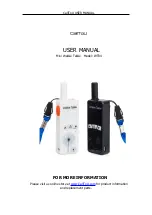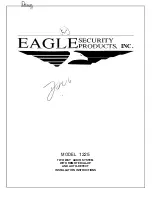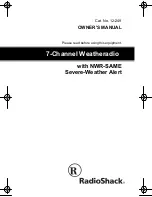
MENTOR
RADIO
CO.
The dial markings of “s-units” on the S-meter are somewhat arbitrary. If the MB receiver
is operating normally, the following data are approximately correct:
reading signal strength microvolts
S1 weak 3
S3 fair 6
S5 good 12
S7 very good 25
S9 strong 50
above S9 very strong 50-50,000
It takes about an S1 signal to “break squelch” at the minimum squelch setting. If the op-
erator observes some small needle deflections, but hears no sound in the speaker, he can
unsquelch the radio to determine whether the calls are directed to his station.
If the Model MB has more than one channel, the rotary channel switch on the front panel is
used to select the desired channel. Transmit and receive frequencies are switched simulta-
neously. Changing the switch position connects a different pair of crystals (one each for
receiving and transmitting) and readjusts all tuned circuits for the new channel. There may
be small channel-to-channel variations in receiver sensitivity (as may be indicated by the
speaker noise level) but this will not affect communications significantly. In case of a
communications problem, check that the frequency selector switch has not been inadver-
tently changed to a different channel.
An aviation type noise-canceling microphone is recommended. To transmit, press the
push-to-talk (ptt) switch on the microphone. Hold the microphone close (1/4 inch or 1/2
cm) to your mouth and speak directly into the center of the microphone’s acoustical open-
ing, at a moderate voice level.
While the MB’s audio leveling circuits compensate for variations in microphone output,
“microphone technique” is extremely important for good clear transmissions. Aviation
microphones are purposely designed to be highly directive and are very sensitive to the
distance from the speaker’s mouth. This is done to reduce pick-up of background noise.
It is impossible to overemphasize the importance of holding these microphones close to the
mouth and speaking clearly.
MICROPHONE TECHNIQUE
1. Hold microphone close to mouth (1/4 inch or 1/2 cm)
2. Enunciate clearly
3. Speak with average loudness-not softly (but don’t shout)
If a non-noise canceling pedestal (dispatcher’s) microphone is used, it is not as essential to
hold the microphone close to the mouth. These microphones will pick up more back-
ground and room noise, including the voices of other persons talking, radios playing, etc.
Содержание MB
Страница 7: ...1101242 6 rev 6 98 MENTOR RADIO CO ...

























